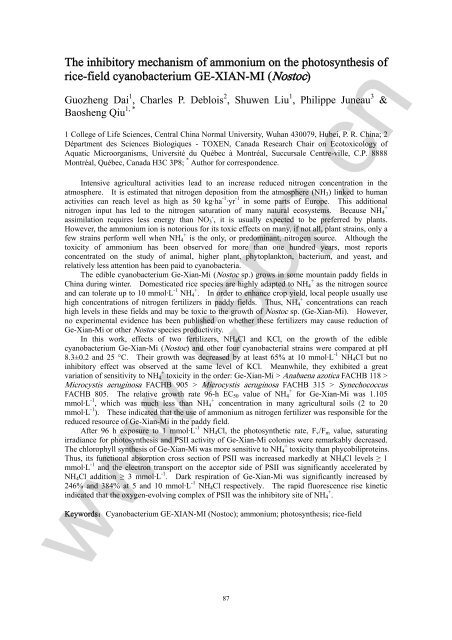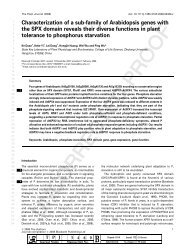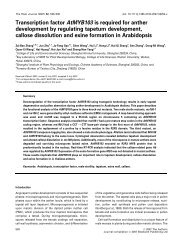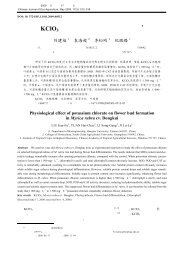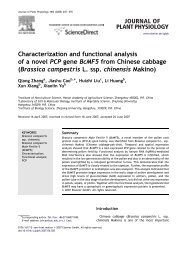Untitled - ä¸å½æ¤ç©ççä¸ååçç©å¦å¦ä¼
Untitled - ä¸å½æ¤ç©ççä¸ååçç©å¦å¦ä¼
Untitled - ä¸å½æ¤ç©ççä¸ååçç©å¦å¦ä¼
You also want an ePaper? Increase the reach of your titles
YUMPU automatically turns print PDFs into web optimized ePapers that Google loves.
The inhibitory mechanism of ammonium on the photosynthesis of<br />
rice-field cyanobacterium GE-XIAN-MI (Nostoc)<br />
Guozheng Dai 1 , Charles P. Deblois 2 , Shuwen Liu 1 , Philippe Juneau 3<br />
Baosheng Qiu 1, *<br />
1 College of Life Sciences, Central China Normal University, Wuhan 430079, Hubei, P. R. China; 2<br />
Départment des Sciences Biologiques - TOXEN, Canada Research Chair on Ecotoxicology of<br />
Aquatic Microorganisms, Université du Québec à Montréal, Succursale Centre-ville, C.P. 8888<br />
Montréal, Québec, Canada H3C 3P8; * Author for correspondence.<br />
Intensive agricultural activities lead to an increase reduced nitrogen concentration in the<br />
atmosphere. It is estimated that nitrogen deposition from the atmosphere (NH 3 ) linked to human<br />
activities can reach level as high as 50 kg·ha -1·yr -1 in some parts of Europe. This additional<br />
+<br />
nitrogen input has led to the nitrogen saturation of many natural ecosystems. Because NH 4<br />
assimilation requires less energy than NO - 3 , it is usually expected to be preferred by plants.<br />
However, the ammonium ion is notorious for its toxic effects on many, if not all, plant strains, only a<br />
few strains perform well when NH + 4 is the only, or predominant, nitrogen source. Although the<br />
toxicity of ammonium has been observed for more than one hundred years, most reports<br />
concentrated on the study of animal, higher plant, phytoplankton, bacterium, and yeast, and<br />
relatively less attention has been paid to cyanobacteria.<br />
The edible cyanobacterium Ge-Xian-Mi (Nostoc sp.) grows in some mountain paddy fields in<br />
China during winter. Domesticated rice species are highly adapted to NH + 4 as the nitrogen source<br />
and can tolerate up to 10 mmol·L -1 NH + 4 . In order to enhance crop yield, local people usually use<br />
high concentrations of nitrogen fertilizers in paddy fields. Thus, NH + 4 concentrations can reach<br />
high levels in these fields and may be toxic to the growth of Nostoc sp. (Ge-Xian-Mi). However,<br />
no experimental evidence has been published on whether these fertilizers may cause reduction of<br />
Ge-Xian-Mi or other Nostoc species productivity.<br />
In this work, effects of two fertilizers, NH 4 Cl and KCl, on the growth of the edible<br />
cyanobacterium Ge-Xian-Mi (Nostoc) and other four cyanobacterial strains were compared at pH<br />
8.3±0.2 and 25 °C. Their growth was decreased by at least 65% at 10 mmol·L -1 NH 4 Cl but no<br />
inhibitory effect was observed at the same level of KCl. Meanwhile, they exhibited a great<br />
variation of sensitivity to NH + 4 toxicity in the order: Ge-Xian-Mi > Anabaena azotica FACHB 118 ><br />
Microcystis aeruginosa FACHB 905 > Microcystis aeruginosa FACHB 315 > Synechococcus<br />
FACHB 805. The relative growth rate 96-h EC 50 value of NH + 4 for Ge-Xian-Mi was 1.105<br />
mmol·L -1 , which was much less than NH + 4 concentration in many agricultural soils (2 to 20<br />
mmol·L -1 ). These indicated that the use of ammonium as nitrogen fertilizer was responsible for the<br />
reduced resource of Ge-Xian-Mi in the paddy field.<br />
After 96 h exposure to 1 mmol·L -1 NH 4 Cl, the photosynthetic rate, F v /F m value, saturating<br />
irradiance for photosynthesis and PSII activity of Ge-Xian-Mi colonies were remarkably decreased.<br />
The chlorophyll synthesis of Ge-Xian-Mi was more sensitive to NH + 4 toxicity than phycobiliproteins.<br />
Thus, its functional absorption cross section of PSII was increased markedly at NH 4 Cl levels ≥ 1<br />
mmol·L -1 and the electron transport on the acceptor side of PSII was significantly accelerated by<br />
NH 4 Cl addition ≥ 3 mmol·L -1 . Dark respiration of Ge-Xian-Mi was significantly increased by<br />
246% and 384% at 5 and 10 mmol·L -1 NH 4 Cl respectively. The rapid fluorescence rise kinetic<br />
indicated that the oxygen-evolving complex of PSII was the inhibitory site of NH + 4 .<br />
Keywords:Cyanobacterium GE-XIAN-MI (Nostoc); ammonium; photosynthesis; rice-field<br />
www.cspp.cn<br />
&<br />
87


